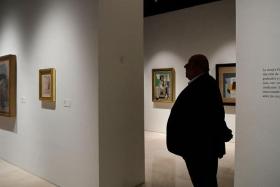Third public statue of Stamford Raffles triggers debate
The commission and installation of a third public statue of Sir Stamford Raffles in Singapore has reignited debate about how the country should critically engage with its colonial history.
Scholars In Conversation: Sir Stamford Raffles & Dr Nathaniel Wallich was unveiled in Fort Canning Park on May 21, at a reception hosted by the National Parks Board and attended by representatives from the British and Danish embassies.
The contemporary life-size bronzes by Wales-based sculptor Andrew Lacey “cost as much as a cheap Porsche” and was paid for in full by the Singapore chapter of the alumni of the University of East Anglia, who wanted to commemorate the university’s 60th anniversary in 2023.
They found that this was close to Singapore’s first botanic garden’s bicentenary in 2022. Set up in 1822 by Raffles and Wallich, the first botanical and experimental garden in Singapore focused largely on cash crops such as nutmeg and cloves, with its historical boundaries along Hill Street, Victoria Street, Bras Basah Road, Handy Road and Canning Rise.
Soon after news of the sculptures broke, criticism surfaced online.
Singapore poet Gwee Li Sui is among those who have found the monument “puzzling”.
Fort Canning Hill’s erstwhile significance as the centre of ancient Temasek and the site of Keramat Iskandar Shah, the rumoured ancient tomb of the last Malay King of Singapura, has also not been lost on critics.
Gwee told The Straits Times: “While around the world, colonial statues are coming down, here, they are going up. It suggests a serious failure to reframe – or at least re-evaluate – received history 200 years later and a related insensitivity to both local history and global feelings about colonialism.”
He also took issue with the memorialising of botanical experiments that were for the purpose of growing cash crops that benefited the British empire. “Colonialism was the start of the destruction and loss of Singapore’s biodiversity. Neutral history is lazy history. Colonialism is not neutral.”
The administrator of The Museum Ghost Instagram account, who declined to give their name, said the salt on the wound is that a British sculptor was commissioned for the work. They called the commission “a love letter to British colonialism in bronze”.
“Why do you still love your ex-overlords? The feeling wasn’t mutual. Ever. Get the hint?” they wrote in a post.
They later told The Straits Times that they do not believe that the history of British colonialism should be erased, but that conversations about it in schools, museums, media and even parks and gardens need to be more conscientious about showing all sides of British rule, its boons as well as its ills.
Faced with these comments, Mr Tan Kee Wee, whose family estate donated the two bronzes, is unperturbed. The University of East Anglia had given him a scholarship to do his doctorate and many of his peers have had lovely experiences in the United Kingdom.
More importantly, he thought the period of British rule in Singapore was relatively benevolent.
“Colonialism in many other countries was quite bad, but in Singapore, it was okay. I’m not sure that the Malay kings did anything for us, whereas Raffles’ town planning still has its impact to this day,” the 67-year-old said.
He chose Lacey as the artist because he met him in 2018 while filming a documentary and enjoyed his style of hollowing out the centre of sculptures, giving his subjects an unconventional lightness.
Few sculptors in Singapore work with bronze because of the lack of a foundry here, Mr Tan added. “There’s always another opportunity. It’s up to groups to find their donors to materialise their ideas.”
Currently, there are at least 20 other sculptures in Fort Canning Park, including many by Singapore artists, such as Han Sai Por, Tan Sock Fong, Baet Yeok Kuan and Ng Eng Teng.
Ambassador at large Professor Tommy Koh said the project proves that Singapore is confident enough about its identity and achievements that it sees no reason to deny history.
“Singapore is contrarian compared with other newly independent countries. They tend to take down colonial era statues or monuments. They change the names of streets and places. We don’t do that. I like to be a contrarian,” he said.
During the Singapore Bicentennial in 2019, four temporary sculptures of Sang Nila Utama, Tan Tock Seng, Munshi Abdullah and Naraina Pillai were placed in dialogue with one of Raffles at the Singapore River, presenting a more nuanced view of history. These were removed after the event and not preserved.
The majority of people in Singapore are unlikely to care about yet another figurative bronze sculpture.
For the curious, this episode has highlighted the links between East Anglia and botany in Singapore: Sir Henry Ridley, who was instrumental in promoting rubber trees in the Malay peninsula, was from East Anglia.
Get The New Paper on your phone with the free TNP app. Download from the Apple App Store or Google Play Store now


